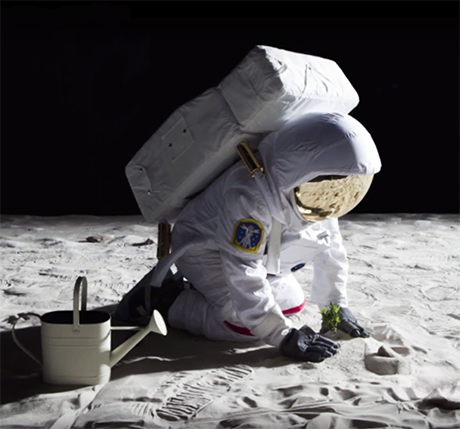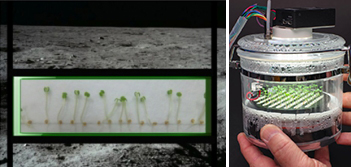
As allergy season gears up in the northern hemisphere, yesterday brought news that even leaving the planet will bring no relief. A press release announcing the publication of a new paper in the journal GeoHealth warned that future astronauts may well suffer from “lunar hay fever,” complete with the characteristic sneezing, watery eyes, and sore throat.
In a fever of my own, I immediately assumed the research was about how the Moon-based agriculture of tomorrow will likely introduce new seasonal allergies into an otherwise season-less lunar year—and thus markers for a new, extra-terrestrial almanac. The term “hay fever”, after all, refers to the malady’s principal trigger: pollen from grasses, levels of which peak between May and July in much of the Northern Hemisphere, before the stems are cut down and bundled to make hay. John Bostock, the British doctor popularly regarded as the “father of hay fever science,” seems to have been the first to use the term in 1828, in follow-up to a 1819 paper that presented his own symptoms in a thinly disguised case study.
“With respect to what is termed the exciting cause of the disease, since the attention of the public has been turned to the subject,” he wrote, “an idea has very generally prevailed, that it is produced by the effluvium from new hay and it has hence obtained the popular name of hay-fever.”
In Bostock’s own opinion, the rays and heat of the sun were to blame; the earliest mention of seasonal catarrh, in a Persian text from 865, pointed the finger at roses instead. (It was titled “On the Reason why the Heads of People Swell at the Time of Roses and Produce Catarrh.”) Indeed, though Europeans appeared to be unaware of this paper, as of much Islamic knowledge, in the 1500s, Italian doctors referred to rare cases of seasonal allergies as “the rose cold.” In 1565, for example, Leonhardus Botallus of Pavia described persons “who held the smell of roses in deadly hatred because it gave rise to headache, sneezing and troublesome itching of the nose.”
By the mid-1850s, hay fever had become well recognised, at least in Britain—indeed, a German researcher labeled England as the “haunt of hay fever.” No less a personage than the King, William IV, was said to be a sufferer, reportedly escaping to Brighton to breathe the sea air each summer.
Intriguingly, the rapid rise of hay-fever took place during a time of equally rapid urbanisation in the U.K., as well as agricultural intensification, as a shrinking group of farmers fed a growing population. This link was pointed out in 1873, by another British scientist with hay-fever, Charles Blackley, who tested coumarin, the molecule responsible for the scent of newly mown hay, before narrowing in on the true cause: pollen.

IMAGE: LPX, or the Lunar Plant Growth Experiment. Photographs courtesy NASA Ames.
But, sadly, for a term so bound up with the history of agriculture, hay fever has since come to mean any form of allergic rhinitus, or nasal inflammation triggered by the immune system in response to atmospheric allergens. Thus, it turns out that the irritants responsible for the “lunar hay fever” mentioned in this new GeoHealth paper are in its soil, rather than its future crops. (Indeed, the term “lunar hay fever” was coined way back in 1972, by Apollo 17 astronaut Harrison Schmitt, to describe the watery eyes and sneezing fits he suffered after breathing in the lunar dust brought back into the command module on the surface of his spacesuit.)
After exposing human lung cells to finely ground-up lunar soil simulants, scientists at Stony Brook University documented significant injury—up to 90 percent of cells were killed, making it impossible to even measure the DNA damage. It seems that tomorrow’s lunar gardeners will have more to worry about than flowering mustard and cress.
3 Comments
Nice to read your writing in this space.
Hope you get relief soon.
Thank you! We’ll see how long it lasts…
So glad to see this blog back into activity!